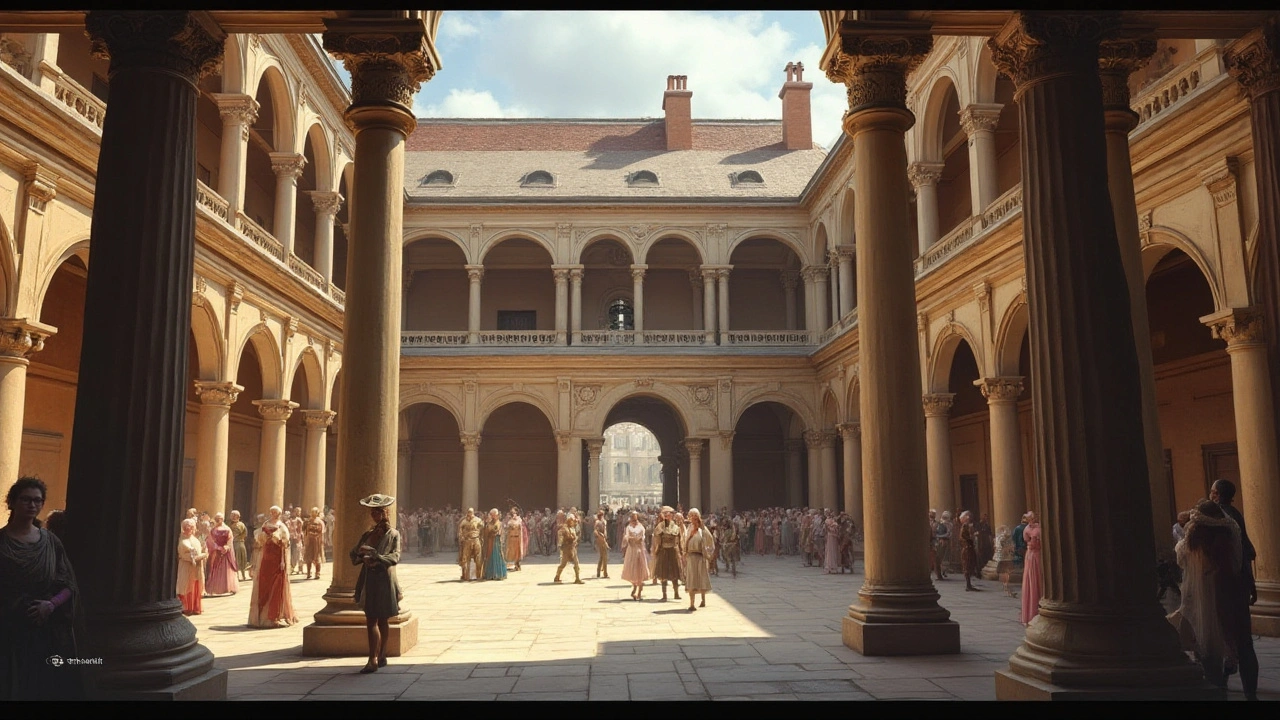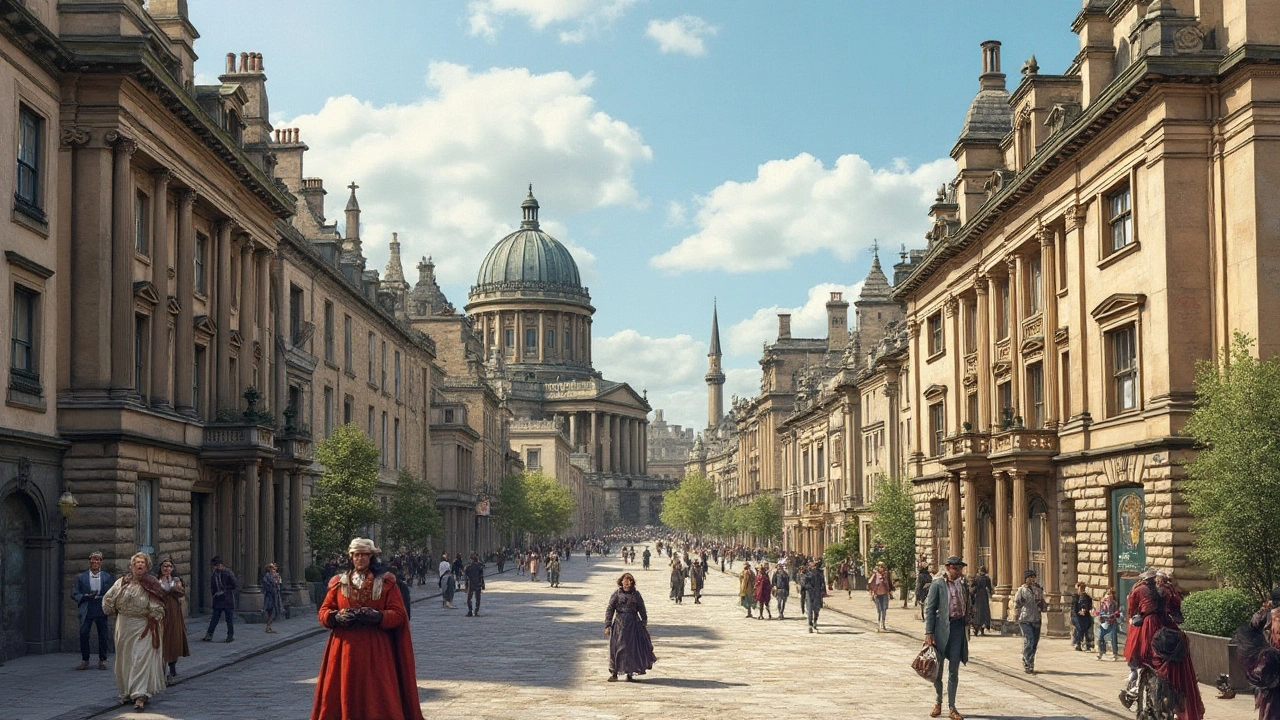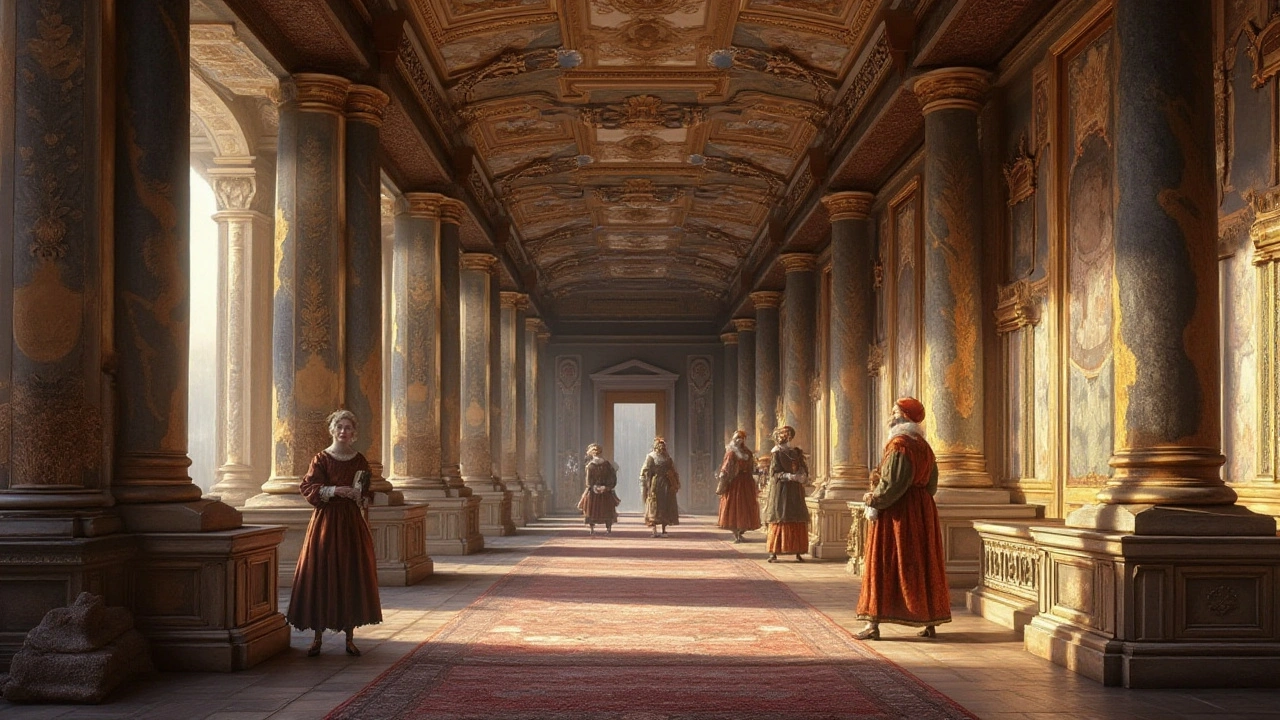Renaissance Architecture: Shaping Modern Aesthetic and Function
 Oct, 28 2024
Oct, 28 2024
The Renaissance period was a time of rebirth, not just in art and literature but also in architecture. This profound era in 15th century Europe was characterized by a renewed interest in the classical ideas of ancient Rome and Greece. The architects of this time sought to create structures that reflected harmony, clarity, and strength, leading to an architectural transformation.
From the majestic cathedrals of Rome to intricate civic buildings in Florence, the essence of Renaissance architecture lay in its innovative approach that married beauty with function. This style emphasized symmetry, proportion, and geometry, using classical elements like columns, domes, and pilasters to create visually pleasing and structurally sound edifices.
The visionaries of Renaissance architecture weren't just builders but artists in their own right. Their works have left an indelible mark on the world, inspiring countless architects and shaping urban landscapes for centuries. Exploring the birth and evolution of this style unveils fascinating insights into how aesthetic principles can last through ages, still echoing in contemporary design practices.
- Origins and Influences
- Defining Features and Innovations
- Iconic Structures and Architects
- Lasting Legacy and Influence Today
Origins and Influences
The Renaissance architecture was born in the heart of 15th century Italy, amid societal shifts and a burgeoning cultural revival. As Europe gradually emerged from the shadow of the medieval period, the Renaissance ignited a fervor for renewal and rediscovery. Influenced heavily by the classical wisdom and artistry of ancient Rome and Greece, architects of this era sought purity in design, embracing a harmonious blend of beauty and function. The sheer intellectual curiosity and wealth of newly translated classical texts spurred this transformation, allowing thinkers and creators to draw deeply from the wellspring of antiquity. The Renaissance Man, as embodied by luminaries such as Leonardo da Vinci, flourished in this environment, where art wasn't a mere luxury but a reflection of cosmic order and human dignity.
In this context, the architectural landscape experienced a seismic shift. For the first time in many centuries, architects were not anonymous craftsmen but prominent civic figures whose creations were celebrated and documented. Filippo Brunelleschi championed this change when he designed the dome of Florence Cathedral. His use of linear perspective and ingenious engineering fostered a paradigm shift. While Brunelleschi was driven by ideas of perfection and order, his work was firmly grounded in the practical needs of burgeoning cities. The vibrant city-states of Italy, bustling with trade and intellectual exchange, became fertile ground for architectural experimentation. The influx of wealth and social transformation allowed buildings not just as places of residence or religious significance but as statements of power and prestige.
This is an era famously captured by Jacob Burckhardt, who wrote, "The Renaissance was the first step into the modern age, as it embraced individualism and revived a cultural identity long repressed."
The Role of Humanism
One of the cornerstones of this architectural renaissance was the philosophical movement known as Humanism. Emphasizing the potential and achievements of humanity, Humanism motivated architects to celebrate the human experience through design. This shift can be seen in how buildings were planned and adorned. Unlike the tall, narrow structures typical of the Gothic style, Renaissance buildings were designed with more spacious, open interiors that encouraged human interaction and contemplation. Public squares, like the famous Piazza della Signoria in Florence, were developed as communal spaces that embodied the democratic spirit and scholarly ideals of the time, where citizens could gather, discuss, and enjoy the shared public realm.
The blend of mathematics, art, and science underscored the principles on which Renaissance architecture was built. Architects meticulously used geometry and proportion to mirror nature's inherent balance, setting a blueprint that many future generations would rely on. The work of Leon Battista Alberti, a true polymath of the period, underscored this synthesis with his treatise "De Re Aedificatoria," which mapped out architectural principles still referenced today. His ideas transcended borders, influencing not just Italy but seeping into the architectural thought of France, England, and beyond. With ancient wisdom as their guide and an eye towards progress, Renaissance architects left an enduring legacy, transforming both the skyline of Europe and the progression of architectural thought for centuries.

Defining Features and Innovations
When we step into a world shaped by Renaissance architecture, we encounter principles of design that fundamentally changed how buildings were conceived. Architects during this golden era pursued innovations that fused practicality with newfound artistic vision. One of the leading features that defined this period was its emphasis on symmetry and geometric order, which instilled a sense of balance that was both visually satisfying and structurally sound. Geometry wasn't just a tool; it was an art in itself, enabling architects to create intricate designs that expressed both beauty and function.
Another hallmark of Renaissance architecture was the revival and adaptation of classical Roman elements, which included columns, arches, and domes. The incorporation of these elements not only added aesthetic value but also served practical purposes, such as providing structural stability. This period also saw the return of the rounded arches and hemispherical domes, deeply inspired by classical antiquity, yet enhanced by the engineering prowess of the Renaissance architects. A keen eye would also notice the ornate facades adorned with classical pilasters and entablatures, paying homage to ancient styles while simultaneously embracing new techniques and aesthetics.
The use of the dome saw unprecedented innovation during this time. Perhaps the most celebrated example is the dome of Florence Cathedral, designed by Filippo Brunelleschi. This architectural marvel was the world's largest dome for centuries, and it was constructed without the use of traditional wooden centering, showcasing a cutting-edge understanding of weight distribution and construction techniques. Such feats were often driven by an ambition to push the boundaries of what was architecturally possible, heralding a new age where the impossible became tangible.
Introducing perspective in architecture was another remarkable development during this period. Architects started to employ linear perspective to create an illusion of three-dimensional space on flat surfaces, enhancing the realism and depth of their buildings. This breakthrough became a defining characteristic of the Renaissance aesthetic, merging mathematics with artistry and giving rise to structures that spoke the new, harmonious visual language.
The era also encouraged a more intimate relationship with nature within architectural designs. Gardens and outdoor spaces became integral parts of structures, reflecting the Renaissance's broader emphasis on the beauty of the natural world. Architects often designed expansive villas with symmetrical gardens, blurring the lines between the built environment and the natural landscape. The fusion of interior and exterior spaces was deliberate, fostering a more holistic approach to living.
While economic and religious institutions spearheaded many Renaissance projects, wealthy patrons seeking to display their power and sophistication also played a significant role. The Medici family in Florence, for instance, commissioned numerous projects that helped propel architectural advancements. This period saw architecture becoming a status symbol, as much a part of the cultural renaissance as painting or sculpture. It was a time where art, culture, and science converged, setting the stage for what many consider the beginning of modern architecture. As the great historian Giorgio Vasari once noted, "Architecture is the book of life constant."
Iconic Structures and Architects
The Renaissance era produced some remarkable architectural marvels that continue to captivate and inspire. Among the legendary figures of Renaissance architecture, Filippo Brunelleschi stands out. Brunelleschi's visionary thinking and innovative engineering laid the foundation for structures that defied the conventions of his time. His crowning achievement, the dome of the Florence Cathedral, is a breathtaking example of this bold new artistic vision. The dome was an engineering triumph that demonstrated the possibilities of combining artistic form with structural ingenuity, and it remains one of the most awe-inspiring landmarks of Renaissance architecture.
Leon Battista Alberti, a contemporary of Brunelleschi, also played a significant role in defining the era's architectural landscape. Alberti was a polymath who believed that architecture was a social art, deeply connected to the communities it served. His treatise, "De re aedificatoria," laid out principles that combined classical knowledge with modern needs. Structures like the Palazzo Rucellai in Florence reveal Alberti's mastery of proportion and harmony, pushing the boundaries of what architecture could achieve. Alberti's ideas have permeated architectural learning across centuries, encouraging a balance between tradition and innovation.
Another impactful figure, Andrea Palladio, left a legacy that continues to influence architectural styles globally. Palladio's works, primarily villas and churches, epitomized the classical ideals of balance, symmetry, and rationality. His book "I Quattro Libri dell'Architettura" became a textbook on architecture and spread his ideas far beyond the borders of Italy. Structures like Villa Rotonda are noted for their elegance and symmetry, illustrating Palladio’s emphasis on proportion and mathematical precision. These buildings showcase the artistic vision that emerged during the Renaissance, demonstrating how classical styles can be reinterpreted for modern aesthetics.
Beyond Italy, Renaissance architecture has left a distinctive mark across Europe. In France, the Château de Chambord captures the grandeur of Renaissance innovation, with its dramatic façade and intricate roofing. Similarly, the influence crossed the English Channel, inspiring the majestic designs of Hardwick Hall and Longleat House, which incorporate Renaissance architectural elements within their unique cultural contexts. The architects behind these constructions took Renaissance ideals and adapted them to their regional tastes, showcasing the style’s versatility and enduring appeal. According to the art historian Giorgio Vasari, "Architecture is an image of beauty" that develops over time, adapting and growing.
These iconic Renaissance architecture structures showcase a period where architectural practice was as much about artistry as it was about utility. They tell stories not just of the buildings themselves but of the architects whose creative visions helped shape the aesthetic of an entire era. The works of these architects serve as a testament to the spirit of discovery that defined the Renaissance, demonstrating that architecture is a living art form that weaves together the present and the past. Their enduring legacy continues to inform and inspire the way we view and interact with our constructed environments today.

Lasting Legacy and Influence Today
The legacy of Renaissance architecture is a thrilling tale of power and beauty that has transcended the centuries to profoundly impact the built world we experience today. This architectural style, with its steadfast emphasis on harmony and balance, is not solely a piece of our past but a continuous dialogue with our present and future. The Renaissance ideals of symmetry and proportion can be seen echoing in the designs of countless modern structures, from the civic buildings that reflect simple geometrical shapes to the grandiose skyscrapers where form and function dance harmoniously. Around the globe, architects draw on these classical principles to create spaces that are both aesthetically pleasing and intricately functional.
In contemporary architecture, one can observe fragments of Renaissance influence in the deliberate use of columns and pilasters, not just as load-bearing elements but as decorative attributes that establish rhythm across facades. Many urban landscapes, especially in Europe, are peppered with revivalist constructions consciously designed to remind us of the intricate beauty and enduring strength encapsulated by Renaissance marvels like the palazzi of Florence. Even in places like the United States, cities host buildings that embrace this classical vibe, imbuing their surroundings with an enduring sophistication born from a time that cherished meticulous detail and artistic satisfaction.
Beyond physical edifices, the Renaissance has imparted significant philosophical insights that continue to inspire today's architectural minds. The era's commitment to scientific inquiry and humanistic thinking encourages architects to innovate while remaining conscientiously grounded in sustainability and urban functionality. By recognizing the importance of incorporating light and space, modern builders and designers draw upon Renaissance truisms to craft environments that enhance human interaction and well-being. The construction of welcoming public spaces that foster community connection is a manifestation of how Renaissance thought continues to forge connections between people and places.
The influence extends beyond mere aesthetics; it provokes thoughtful consideration of how people inhabit spaces, encouraging the integration of eco-conscious materials and technologies. In practicing these principles, modern architects are not creating replicas but are using these centuries-old truths as foundations for progression in an ever-changing landscape. As beautifully articulated by Leon Battista Alberti, ‘Architecture is a social act’—a sentiment that resonates as architects strive for harmony and sustainability in an increasingly urbanized world.
‘A building has to function well, look good, and bear good significance.’ — Robert Venturi, renowned architect
In examining the long-lasting impact of Renaissance architecture, it becomes clear that its influence is deeply woven into the fabric of modern design. The style's ability to inspire, educate, and innovate has solidified its place as a timeless cornerstone in the world of architecture. As we continue to build and envision the spaces of tomorrow, the wisdom of the Renaissance will no doubt remain an inspiring guide, reminding us of the elegant synthesis of art and utility that defines truly exquisite architecture.